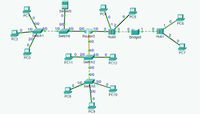
Database System Concepts
7th Edition
ISBN: 9780078022159
Author: Abraham Silberschatz Professor, Henry F. Korth, S. Sudarshan
Publisher: McGraw-Hill Education
expand_more
expand_more
format_list_bulleted
Concept explainers
Question
I have a Networking question.
How to configure these virtual devices to send packets from one network to another through router?

Transcribed Image Text:This image illustrates a network topology diagram suitable for educational purposes, showcasing various network devices and their interconnections.
### Components:
1. **PCs (PC0 to PC12)**: These represent personal computers connected to the network.
2. **Server0**: A server connected to Switch0 via port 0.
3. **Switches (Switch0, Switch1, Switch2, Switch3)**: These devices are used to connect multiple devices within a network.
- **Switch0** connects to Server0 (port 0) and Router0 (port 2).
- **Switch1** connects to PC0 (port 0), PC2 (port 1), and PC3 (port 2).
- **Switch2** connects to PC11 and PC12 through ports 0 and 2, respectively.
- **Switch3** connects PC8 (port 0), PC9 (port 2), and PC10 (port 3).
4. **Router0**: A device that forwards data packets between computer networks. It is connected to:
- Switch0 via port 2
- Hub0 using port 1
- Switch2 via port 2
- PC4 directly via port 0
5. **Hub0**: A device used to connect multiple Ethernet devices together. It connects:
- PC5 via port 2
- Bridge0 via port 3
6. **Bridge0**: A network bridge linked to Hub0 via port 3.
7. **Hub1**: Connects PC6 (port 1) and PC7 (port 2).
### Connections:
- The network diagram shows connections between different network devices indicating the flow of data.
- Connections are marked with port numbers indicating which port on the device is used for the connection.
- The use of switches, hubs, and routers enables the division of the network into smaller segments to manage traffic efficiently.
This layout can be used in educational settings to teach about network architecture and the roles of different network devices.
Expert Solution
This question has been solved!
Explore an expertly crafted, step-by-step solution for a thorough understanding of key concepts.
Step by stepSolved in 2 steps with 1 images

Knowledge Booster
Learn more about
Need a deep-dive on the concept behind this application? Look no further. Learn more about this topic, computer-science and related others by exploring similar questions and additional content below.Similar questions
- What happens to MAC addresses as a packet travels from one network to another? What happens to IP addresses as a packet travels from one network to another?arrow_forwardDescribe the function of a router within the OSI model. In which OSI layers does it operate, and how does it enable communication between different networks?arrow_forwardWhat exactly is a network overlay? Do routers fall under this category? How are the different layers of the overlays in the network connected to one another?arrow_forward
- Is it accurate to say that, in the case of routers, packet routing happens at MAC addresses? If you replied no, could you kindly describe the equipment that would be needed to do the job, along with how it functions, and then please explain how it works.arrow_forwardIs it possible for two network interfaces to have the same MAC address? Why do you think that is? Is it possible for two network interfaces to share one IP address? Why do you think that is?arrow_forwardIs it true that MAC addresses determine how a router routes packets? If yes, explain how you accomplished it; if no, describe the equipment you used and how you did it.arrow_forward
arrow_back_ios
arrow_forward_ios
Recommended textbooks for you
 Database System ConceptsComputer ScienceISBN:9780078022159Author:Abraham Silberschatz Professor, Henry F. Korth, S. SudarshanPublisher:McGraw-Hill Education
Database System ConceptsComputer ScienceISBN:9780078022159Author:Abraham Silberschatz Professor, Henry F. Korth, S. SudarshanPublisher:McGraw-Hill Education Starting Out with Python (4th Edition)Computer ScienceISBN:9780134444321Author:Tony GaddisPublisher:PEARSON
Starting Out with Python (4th Edition)Computer ScienceISBN:9780134444321Author:Tony GaddisPublisher:PEARSON Digital Fundamentals (11th Edition)Computer ScienceISBN:9780132737968Author:Thomas L. FloydPublisher:PEARSON
Digital Fundamentals (11th Edition)Computer ScienceISBN:9780132737968Author:Thomas L. FloydPublisher:PEARSON C How to Program (8th Edition)Computer ScienceISBN:9780133976892Author:Paul J. Deitel, Harvey DeitelPublisher:PEARSON
C How to Program (8th Edition)Computer ScienceISBN:9780133976892Author:Paul J. Deitel, Harvey DeitelPublisher:PEARSON Database Systems: Design, Implementation, & Manag...Computer ScienceISBN:9781337627900Author:Carlos Coronel, Steven MorrisPublisher:Cengage Learning
Database Systems: Design, Implementation, & Manag...Computer ScienceISBN:9781337627900Author:Carlos Coronel, Steven MorrisPublisher:Cengage Learning Programmable Logic ControllersComputer ScienceISBN:9780073373843Author:Frank D. PetruzellaPublisher:McGraw-Hill Education
Programmable Logic ControllersComputer ScienceISBN:9780073373843Author:Frank D. PetruzellaPublisher:McGraw-Hill Education

Database System Concepts
Computer Science
ISBN:9780078022159
Author:Abraham Silberschatz Professor, Henry F. Korth, S. Sudarshan
Publisher:McGraw-Hill Education

Starting Out with Python (4th Edition)
Computer Science
ISBN:9780134444321
Author:Tony Gaddis
Publisher:PEARSON

Digital Fundamentals (11th Edition)
Computer Science
ISBN:9780132737968
Author:Thomas L. Floyd
Publisher:PEARSON

C How to Program (8th Edition)
Computer Science
ISBN:9780133976892
Author:Paul J. Deitel, Harvey Deitel
Publisher:PEARSON

Database Systems: Design, Implementation, & Manag...
Computer Science
ISBN:9781337627900
Author:Carlos Coronel, Steven Morris
Publisher:Cengage Learning

Programmable Logic Controllers
Computer Science
ISBN:9780073373843
Author:Frank D. Petruzella
Publisher:McGraw-Hill Education